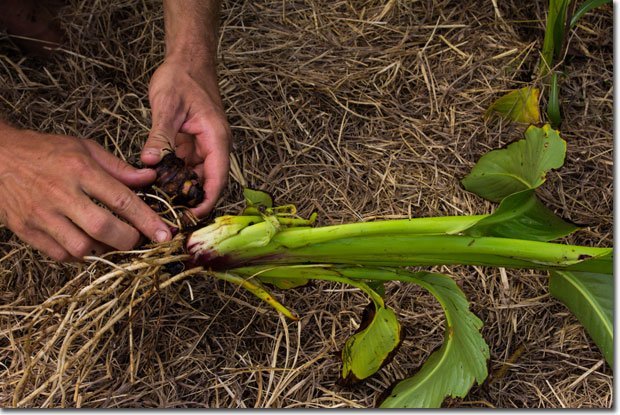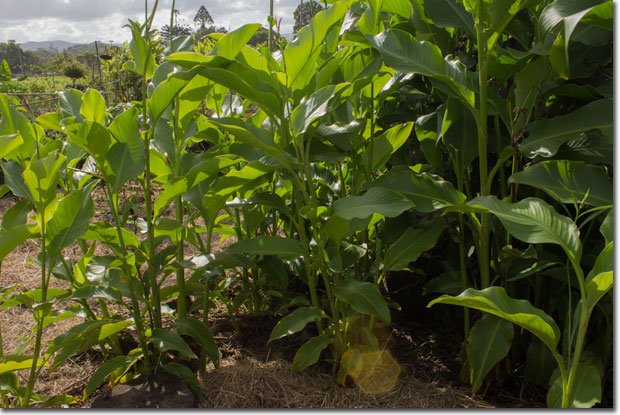Growing Queensland Arrowroot- Canna Edulis
Canna edulis is a perennial root crop also known as Achira or here in Australia as Queensland Arrowroot. I’m not sure where the Queensland bit came from because they originated from South America. They are quite stunning plants popular with ornamental growers, although the ornamental varieties produce smaller crops with flashier flowers. They can grow up to 2 meters plus in full sun or part shade in damp soils and it spreads underground via rhizomes to form large clumps even in poor soils.
It is commonly used in Permaculture designs as a windbreak, as chop and drop biomass, as fodder for pigs and possibly chickens and it can also be planted to form a suntrap. The rhizomes form large starchy tubers that are a great substitute for potatoes and the immature seeds and young shoots can be eaten as well.
Queensland Arrowroot is mainly propagated via root division. Simply dig up a handful of rhizomes from an established clump, split them apart into individual bulbs and replant them. It’s a good idea to cut away excess foliage when replanting so that the freshly planted arrowroot can focus on growing roots.
Being a tropical to sub-tropical plant the foliage is sensitive to frost. If you live in a climate with only light frosts then it should be possible to grow, but if your climate is cold enough to freeze the ground then you would need to dig up the rhizomes and bring them indoors for winter.
Don’t worry if your soil isn’t massively fertile, QLD Arrowroot can grow well in poor soils, just make sure it gets plenty of water.
They are quite stunning plants popular with ornamental growers, although the ornamental varieties produce smaller crops with flashier flowers.
Visit Todd’s own website, deep living, here
















Canna!!?? How amazing! We’ve seen these and had them in so many gardens (even in India), never realising they might be edible. Thank you Todd, thank you Permaculture.
no problemo! happy to share
The Queensland part comes because it used to be a major industry in Queensland for the production of starch. It died out because harvesting the crop was done by hand, and machines for processing grain crops were invented but arrowroot was never big enough to be industrialised. Arrowroot biscuits here now only have <1% arrowroot flour in them.
As for cooking with them, I have found the grated roots are acceptable to eat if you fry them with a bit of bacon, though they are quite fibrous. It is pretty easy to squeeze the large starch grains from the grated root instead and use it as a gluten free flour. I swell the starch by cooking it over a low heat into a thick paste, stir in egg yolks and flavouring like fruit pulp, then fold into whipped egg whites and bake in ramekins to make a kind of souffle/pudding. I'll have to try drying the flour down one day and making 100% arrowroot biscuits.
It is worth pointing out that there is a new virus in Canna in Australia that causes yellow leaf splotches and eventually kills the plant. Since Qld arrowroot is a sterile hybrid and can only be reproduced by division it pays to be careful not to introduce the virus into your garden.
wow! excellent information Shazz. Interesting about the starch industry and good to know about the possible virus issues too!
Thanks Shazz. How can we prevent/contro lthe new virus? How is it different from naturally dying leaves? I guess affected leaves would have to be burned?
Hope to see these big tubers next time. Nice plant I like it too. Flour can be made from it to make cakes.
Besides cakes, toloman’s starch is also used to thicken sauces and baby bottles. Is asia, it has plenty of other uses…
The foliage of arrowroot also makes great goat and cattle fodder. I use them as nursery plants, planting other things (such as ginger, turmeric, yacon, but I am sure there are many more that would appreciate the shelter as they get established) among them for protection from the sun, and then thinning out the arrowroot as the other plants become more established and need more space. As I thin the arrowroot, I throw the tubers to the pigs and take the foliage to the goats. A beautiful and versatile plant!
Thanks for sharing Kate! I’ve read about it being used as animal fodder but didn’t have first hand experience with it. Using it as a nursery plant is brilliant, it seems perfect for it.
Our chickens like the leaves. We grab a handful of leaves periodically and throw them to the chickens which are in a moveable coop on our vegetable garden. We know this plant here in Northwest Florida as “edible canna”.
Hi every one!!! grateful impressed about this plant, never have thought it was edible. I m from Spain, and loking for more details in google, i write ‘canna edulis’ and it just give me back ‘canna indica’. Is it the same plant??? Thx and sorry for my english! love your articles!
Yes you are right is the same plant. Canna indica [=from india in Latin] or canna edulis [=edible] are the same..There are more than 80 names fo this plant. But there are also others plants in the canna family… You may have found this by yourself by now https://en.wikipedia.org/wiki/List_of_Canna_species
No they are not the same.
Thx for the info!!!! i ll try to cook it soon, we have it in the public garden here,hehe.
I am trialling how best to feed the leaves and young stems of the canna to my chickens – they are apparently 10% protein.
Any idea on how this plant performs in part shade?
It will grow in shade reasonably well, but the tubers will be undersized. If you are using it as a soft grass stopping hedge it will still help, and the leaves would still make reasonable animal fodder.
Are all cannas edible please or is it just the canna edulis
I started some from seed last April, all sprouted and grew rapidly into really gorgeous plants, started blooming in August. However, the leaves on mine have a deep reddish cast instead of green like the picture on this website. They were listed in the seed catalog as Queensland Arrowroot, but now I’m wondering if they’re another variety, although the flowers look the same.
Canna indica and Canna edulis are quite different.
Canna indica sets seed so can be more invasive, and though it’s corms are edible they are much smaller, and vastly inferior to those of canna edulis which is more recently classified as Canna discolour.
I have 3 varieties of this, 2 of which I was first growing in New Zealand 25 years ago.
My favourite way to prepare them back then was just roast them, skin on, in the embers of a fire!
So no prep needed for cooking?
I was going to throw them in the oven like potatoes and see how they are, or maybe in a stir fry?
I thought you may have to do something special so as not to get a stomach ache?? 🤒
Jerry notes that you can soak them in water before eating to improve the taste https://www.abc.net.au/gardening/factsheets/arrowroot-and-peanuts/9426614 . I’m experimenting in cooking with them at the moment. They are delicious when cut into small chunks and cooked with rice… they add a nice earthy flavour and texture to the rice. Before cooking them in in this way I steam them first (after soaking). I do this preparation in large batches then freeze the chunks, ready for further cooking when needed. Tastes like parsnip, similar texture too.